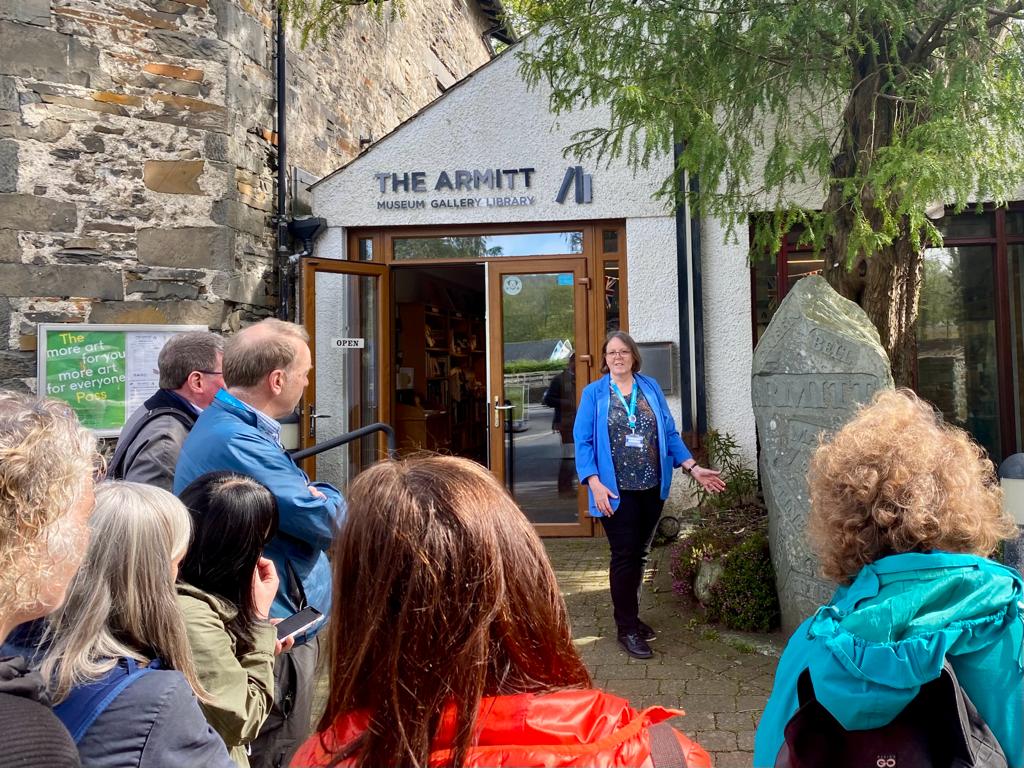Amble around Ambleside

It's been a wonderful and busy week for me as a Blue Badge Tourist Guide based in Ambleside. One day I was leading a walking tour around Ambleside for a very attentive group of Cumbria Blue Badge Guides as part of their CPD (continued professional development) and on another I was being recorded for an audio podcast ahead of the launch of a new guidebook, a walking companion, in which I have written a brief history of Ambleside...(brief? - it covers thousands of years!).
The Blue Badge Guides were also treated to an escape into the countryside as I shared with them a hidden gem. A special place for a relaxing afternoon in a quiet location just ten minutes from Ambleside with beautiful views of the Langdale Pikes for some down-time with some wonderfully calm horses.
I love to reveal the stories of Ambleside's 600 year-long industrial past and the people who helped shape it to become the town it is today as we weave our way under buildings (yes, under!), explore the narrow backstreets and see the Westmorland round chimneys which once belonged to important Halls and buildings dating back to the 1500s. As people pass through this busy little town on its one-way system heading for Grasmere or the North Lakes, they pass the iconic Bridge House and could easily leave with the impression that this is just a place that sells a "Profusion of Anoraks" - yes there was once a sign above a shop that actually said just that..
But did you know?
- 6,000 years ago not far from here on the Langdale Pikes Neolithic man was extracting stone for axe heads
- In AD79 when the Romans were extending their Empire northwards they arrived in Ambleside and built a fort at the head of England's longest lake less than one mile from the centre of Ambleside. A few decades later they rebuilt it in stone - the outline of the fort buildings are still visible today.
Walk with me to discover the history of Ambleside - the industrial powerhouse - an industry that survived using local and natural renewable energy for over 600 years and...
- an incredible legacy of a local young man whose vision continues to support the town’s children 300 years after he died,
- the woman whose education methods are still followed as 2023 marks the centenary of her death
... and find out why the area became so popular with writers, poets, education reformers, journalists and artists including William Wordsworth, Beatrix Potter, William Green, Harriet Martineau, Charlotte Mason, Kurt Schwitters - even JMW Turner came here to sketch. Authors including Charles Dickens, John Keats and Charlotte Bronte visited and wrote of their "trip advisor" reviews.
But hear of the unsung heroes too for if we don't tell their stories they will be lost in time. Who was the extraordinary postmistress who helped to build the church, what and when was the Battle of Stock Ghyll and why are the hotel frontages facing the "wrong way" as you make your way southwards through town?
Groups of a maximum of 10 persons, at £10 per head for either a town walk or a "mills only" walk, each lasting approximately 90 minutes can be pre-booked via my contact page. As both walks contains steps, steep paths and roads with two-way traffic and narrow or no pavements please let me know in advance if there are any mobility concerns. The walk does not include a visit to The Roman fort (which is free of charge to visit and open all hours) or admission to any attractions.
The Meditation with Horses is bookable separately with a guided meditation which can be tailored to the requirements of both adults and children. I will accompany you as this experience is provided by a different organisation specialising in wellness retreats.
